# 定位(position)
# 元素的定位属性
元素的定位属性主要包括定位模式和边偏移两部分。
1、边偏移
| 边偏移属性 | 描述 |
|---|---|
| top | 顶端偏移量,定义元素相对于其父元素上边线的距离 |
| bottom | 底部偏移量,定义元素相对于其父元素下边线的距离 |
| left | 左侧偏移量,定义元素相对于其父元素左边线的距离 |
| right | 右侧偏移量,定义元素相对于其父元素右边线的距离 |
也就说,以后定位要和这边偏移搭配使用了, 比如 top: 100px; left: 30px; 等等
2、定位模式
在CSS中,position属性用于定义元素的定位模式,其基本语法格式如下:
选择器{position:属性值;}
position属性的常用值
| 值 | 描述 |
|---|---|
| static | 自动定位(默认定位方式) |
| relative | 相对定位,相对于其原文档流的位置进行定位 |
| absolute | 绝对定位,相对于其上一个已经定位的父元素进行定位 |
| fixed | 固定定位,相对于浏览器窗口进行定位 |
# 静态定位(static)
静态定位是所有元素的默认定位方式,当position属性的取值为static时,可以将元素定位于静态位置。 所谓静态位置就是各个元素在HTML文档流中默认的位置。
上面的话翻译成白话: 就是网页中所有元素都默认的是静态定位哦! 其实就是标准流的特性。
在静态定位状态下,无法通过边偏移属性(top、bottom、left或right)来改变元素的位置。
PS: 静态定位其实没啥可说的。
# 相对定位relative(自恋型)
小笑话:
刚刚看到一个超级超级帅的帅哥,看得我都忍不住想和他搞基了。世间怎会有如此之完美的男人。我和他就这样一动不动的对视着,就仿佛一见钟情。时间也在这一瞬间停止了。直到我的手麻了。才恋恋不舍的放下镜子。。。。
2
相对定位是将元素相对于它在标准流中的位置进行定位,当position属性的取值为relative时,可以将元素定位于相对位置。
对元素设置相对定位后,可以通过边偏移属性改变元素的位置,但是它在文档流中的位置仍然保留。如下图所示,即是一个相对定位的效果展示:
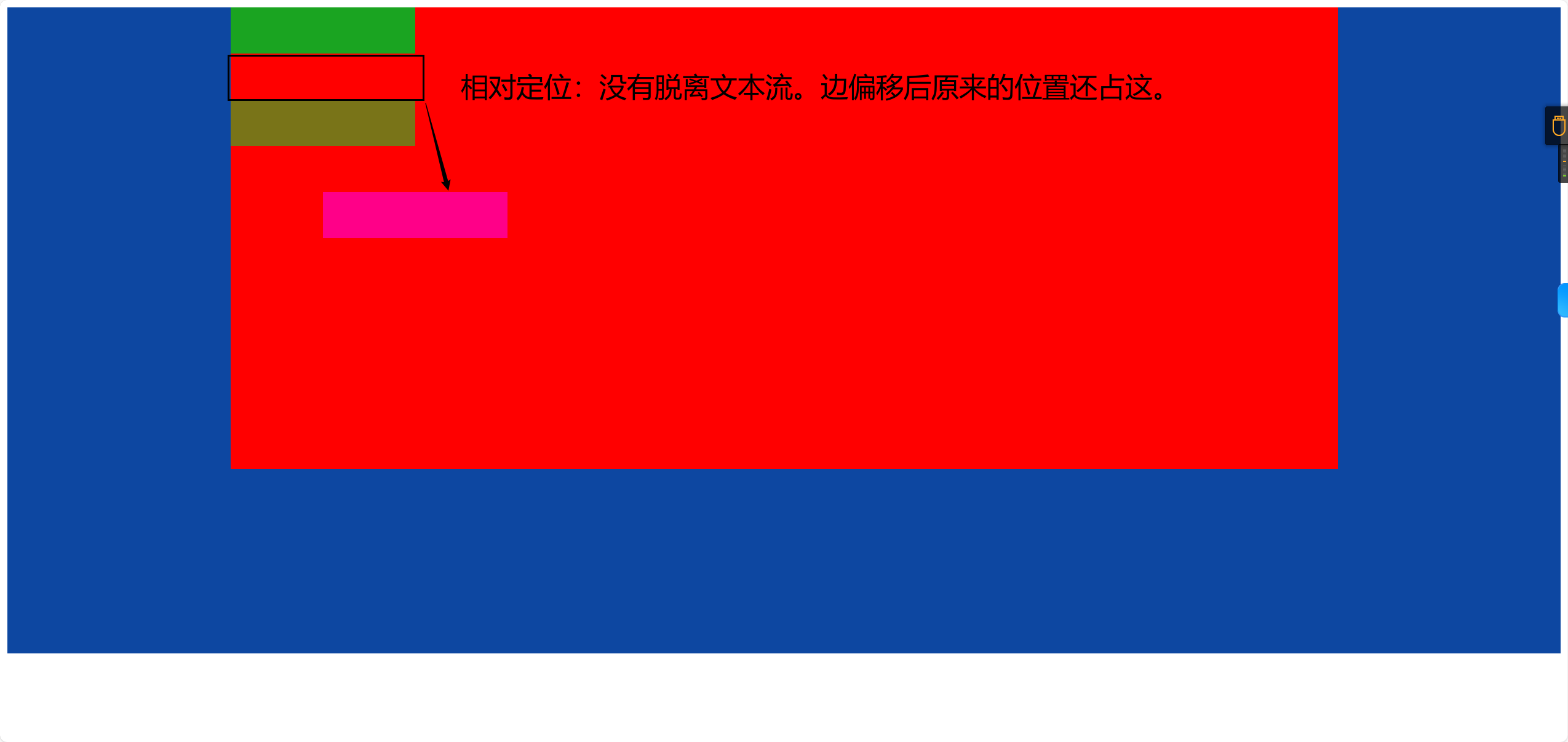
<!DOCTYPE html>
<html lang="en">
<head>
<meta charset="UTF-8">
<title>相对定位</title>
<style>
.container {
background-color: #0d47a1;
width: 100%;
height: 700px;
}
.demo {
margin: 0 auto;
background-color: red;
width: 1200px;
height: 500px;
}
.item1 {
width: 200px;
height: 50px;
background-color: #1aa421;
}
.item2 {
width: 200px;
height: 50px;
background-color: #ff0088;
position: relative;
left: 100px;
top: 150px;
}
.item3 {
width: 200px;
height: 50px;
background-color: #797418;
}
</style>
</head>
<body>
<div class="container">
<div class="demo">
<div class="item1"></div>
<div class="item2"></div>
<div class="item3"></div>
</div>
</div>
</body>
</html>
2
3
4
5
6
7
8
9
10
11
12
13
14
15
16
17
18
19
20
21
22
23
24
25
26
27
28
29
30
31
32
33
34
35
36
37
38
39
40
41
42
43
44
45
46
47
48
49
50
51
52
53
54
# 绝对定位absolute (拼爹型)
小笑话:
吃早饭时,老婆往儿子碗里放了两个煎蛋,儿子全给了我,还一本正经地说:“爸爸,多吃点,男人养家不容易。” <br/>
我一阵感动,刚想夸他两句。
儿子接着说:“以后全靠你让我拼爹了!”
2
3
4
[注意] 如果文档可滚动,绝对定位元素会随着它滚动,因为元素最终会相对于正常流的某一部分定位。
当position属性的取值为absolute时,可以将元素的定位模式设置为绝对定位。
注意:绝对定位最重要的一点是,它可以通过边偏移移动位置,但是它完全脱标,完全不占位置。
# 情况1)父级没有定位
若所有父元素都没有定位,以浏览器为准对齐(document文档)。
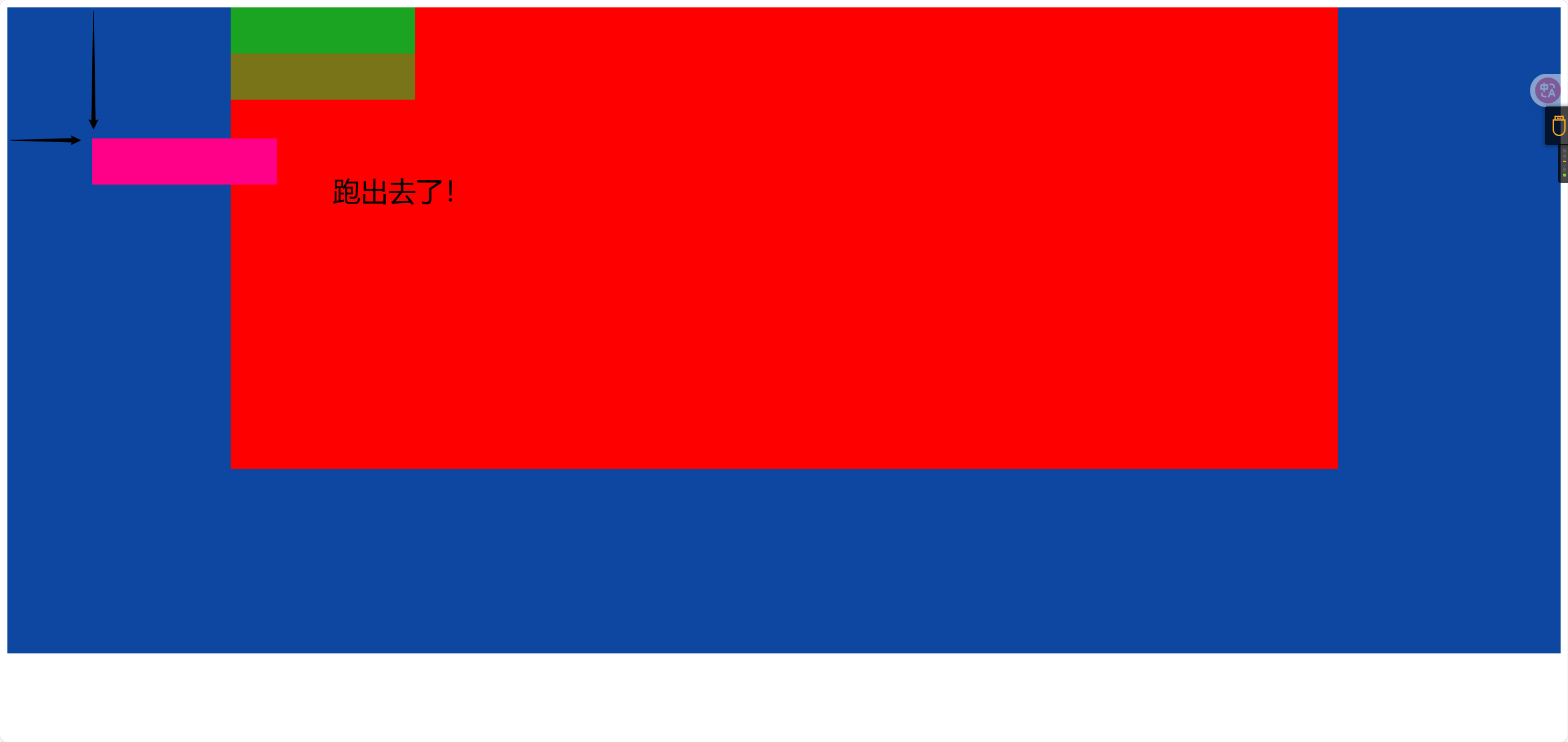
<!DOCTYPE html>
<html lang="en">
<head>
<meta charset="UTF-8">
<title>相对定位</title>
<style>
.container {
background-color: #0d47a1;
width: 100%;
height: 700px;
}
.demo {
margin: 0 auto;
background-color: red;
width: 1200px;
height: 500px;
}
.item1 {
width: 200px;
height: 50px;
background-color: #1aa421;
}
.item2 {
width: 200px;
height: 50px;
background-color: #ff0088;
position: absolute;
left: 100px;
top: 150px;
}
.item3 {
width: 200px;
height: 50px;
background-color: #797418;
}
</style>
</head>
<body>
<div class="container">
<div class="demo">
<div class="item1"></div>
<div class="item2"></div>
<div class="item3"></div>
</div>
</div>
</body>
</html>
2
3
4
5
6
7
8
9
10
11
12
13
14
15
16
17
18
19
20
21
22
23
24
25
26
27
28
29
30
31
32
33
34
35
36
37
38
39
40
41
42
43
44
45
46
47
48
49
50
51
52
53
54
# 情况2)父级有定位
绝对定位是将元素依据最近的已经定位(绝对、固定或相对定位)的父元素(祖先)进行定位。
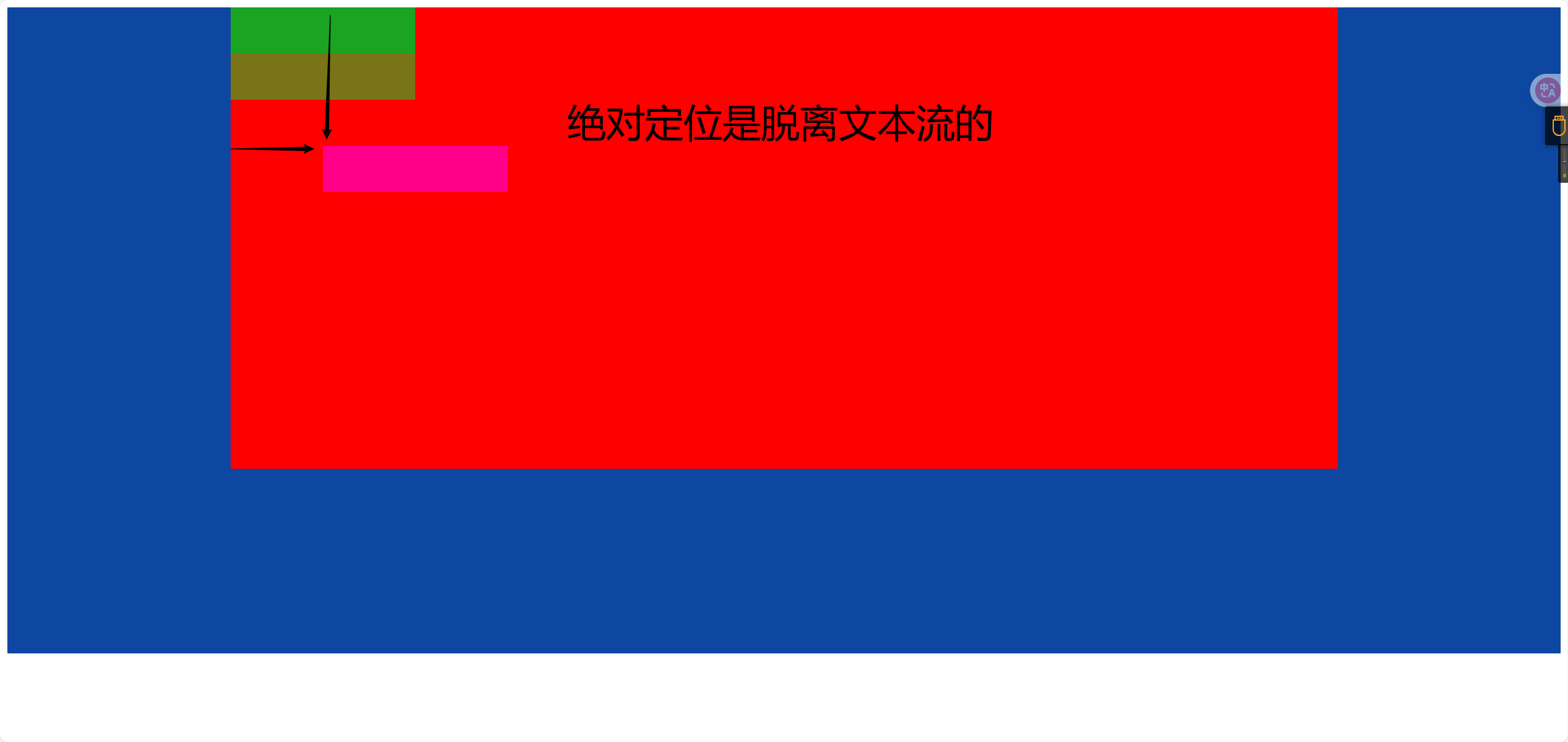 父亲元素使用相对定位(relative)。
父亲元素使用相对定位(relative)。
<!DOCTYPE html>
<html lang="en">
<head>
<meta charset="UTF-8">
<title>相对定位</title>
<style>
.container {
background-color: #0d47a1;
width: 100%;
height: 700px;
}
.demo {
margin: 0 auto;
background-color: red;
width: 1200px;
height: 500px;
position: relative;
}
.item1 {
width: 200px;
height: 50px;
background-color: #1aa421;
}
.item2 {
width: 200px;
height: 50px;
background-color: #ff0088;
position: absolute;
left: 100px;
top: 150px;
}
.item3 {
width: 200px;
height: 50px;
background-color: #797418;
}
</style>
</head>
<body>
<div class="container">
<div class="demo">
<div class="item1"></div>
<div class="item2"></div>
<div class="item3"></div>
</div>
</div>
</body>
</html>
2
3
4
5
6
7
8
9
10
11
12
13
14
15
16
17
18
19
20
21
22
23
24
25
26
27
28
29
30
31
32
33
34
35
36
37
38
39
40
41
42
43
44
45
46
47
48
49
50
51
52
53
54
55
父亲元素使用绝对定位(absolute)。
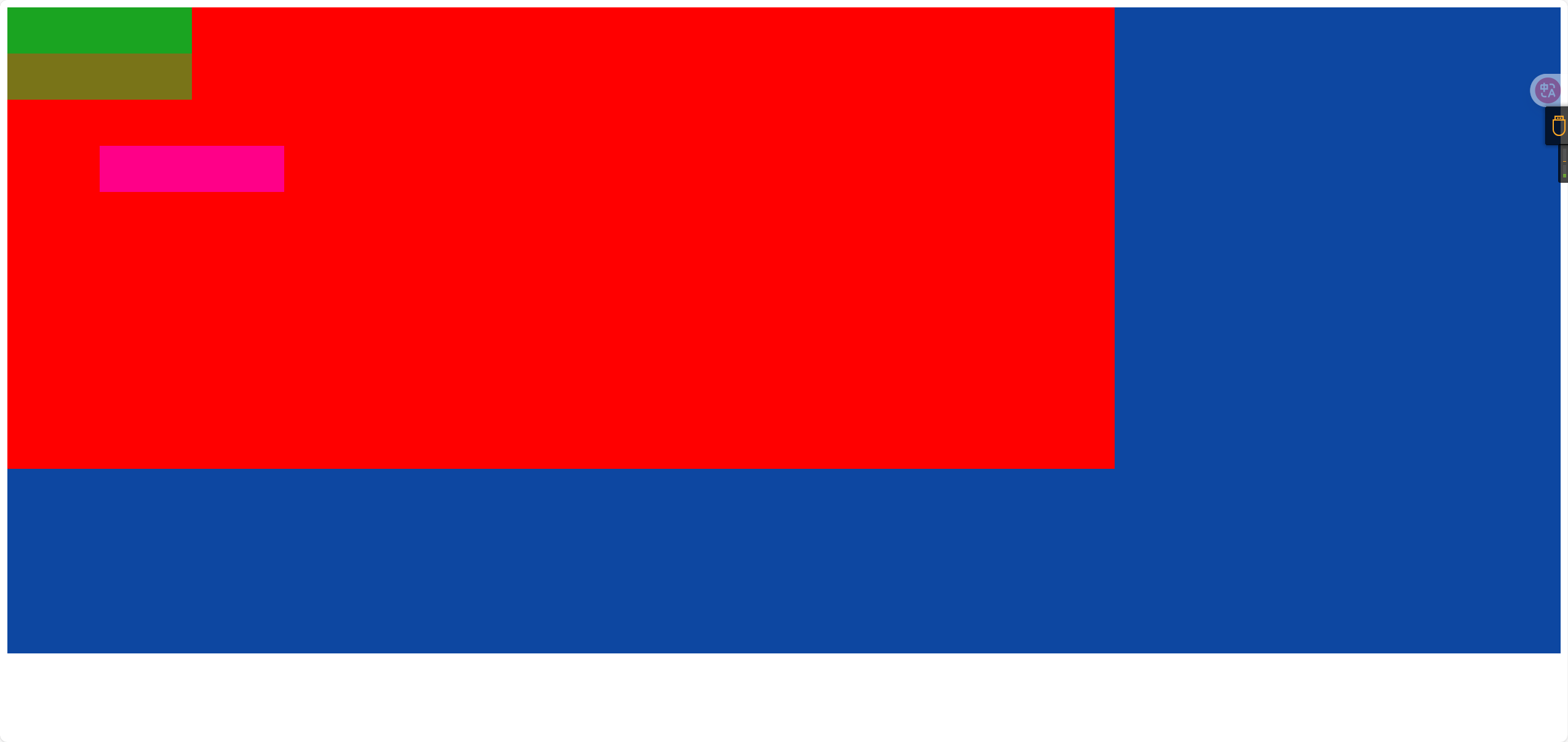
<!DOCTYPE html>
<html lang="en">
<head>
<meta charset="UTF-8">
<title>相对定位</title>
<style>
.container {
background-color: #0d47a1;
width: 100%;
height: 700px;
}
.demo {
margin: 0 auto;
background-color: red;
width: 1200px;
height: 500px;
position: absolute;
}
.item1 {
width: 200px;
height: 50px;
background-color: #1aa421;
}
.item2 {
width: 200px;
height: 50px;
background-color: #ff0088;
position: absolute;
left: 100px;
top: 150px;
}
.item3 {
width: 200px;
height: 50px;
background-color: #797418;
}
</style>
</head>
<body>
<div class="container">
<div class="demo">
<div class="item1"></div>
<div class="item2"></div>
<div class="item3"></div>
</div>
</div>
</body>
</html>
2
3
4
5
6
7
8
9
10
11
12
13
14
15
16
17
18
19
20
21
22
23
24
25
26
27
28
29
30
31
32
33
34
35
36
37
38
39
40
41
42
43
44
45
46
47
48
49
50
51
52
53
54
55
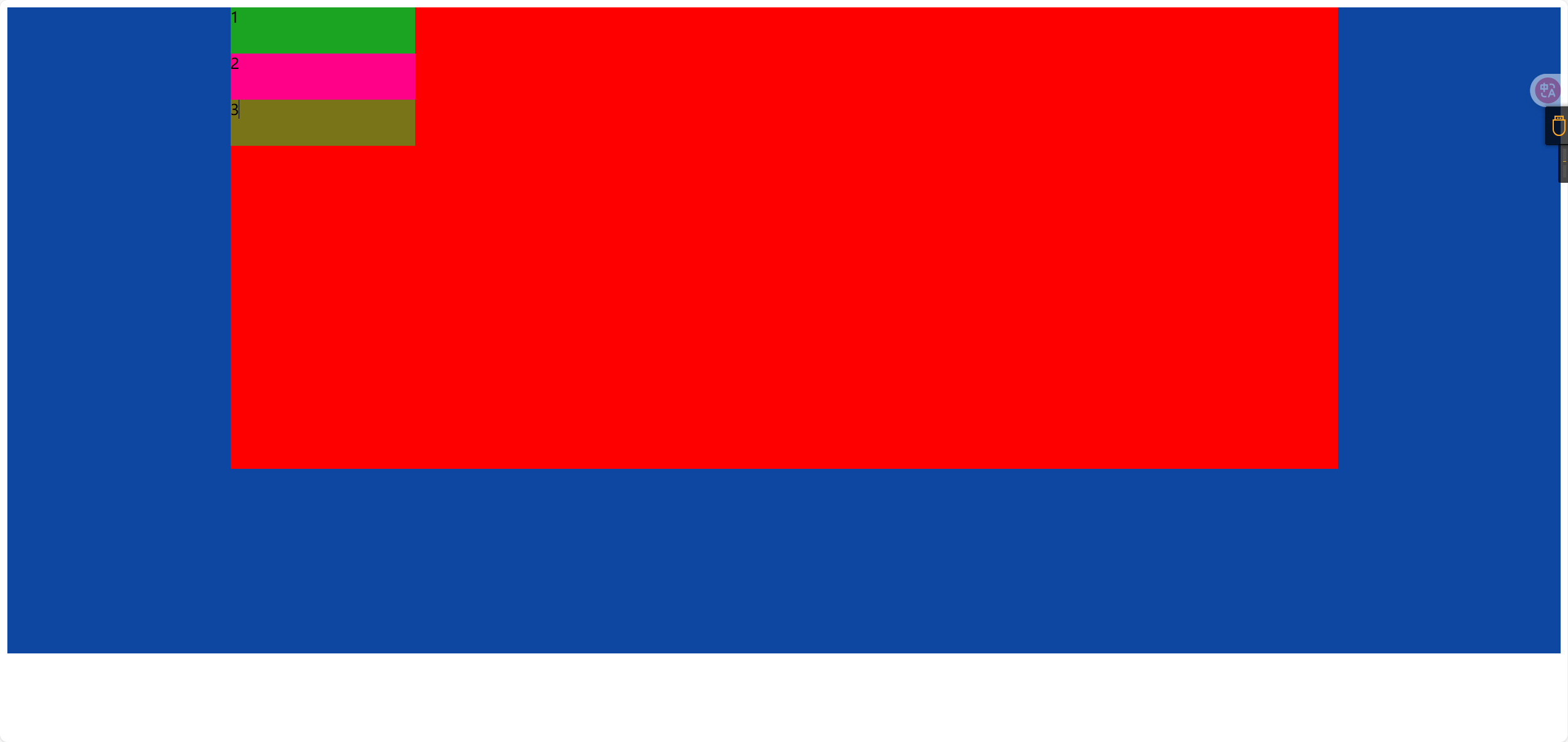
<!DOCTYPE html>
<html lang="en">
<head>
<meta charset="UTF-8">
<title>相对定位</title>
<style>
.container {
background-color: #0d47a1;
width: 100%;
height: 700px;
}
.demo {
margin: 0 auto;
background-color: red;
width: 1200px;
height: 500px;
position: relative;
}
.item1 {
width: 200px;
height: 50px;
background-color: #1aa421;
}
.item2 {
width: 200px;
height: 50px;
background-color: #ff0088;
}
.item3 {
width: 200px;
height: 50px;
background-color: #797418;
}
</style>
</head>
<body>
<div class="container">
<div class="demo">
<div class="item1">1</div>
<div class="item2">2</div>
<div class="item3">3</div>
</div>
</div>
</body>
</html>
2
3
4
5
6
7
8
9
10
11
12
13
14
15
16
17
18
19
20
21
22
23
24
25
26
27
28
29
30
31
32
33
34
35
36
37
38
39
40
41
42
43
44
45
46
47
48
49
50
51
52
如果只是给盒子指定了定位,但是没有给边偏移值,则盒子以标准流来显示排序,和上一个盒子的底边对齐,但是不占有位置【说明后面盒子会顶上来,如下图就是】。
TIP
只给2有absolute定位,其他的不给定位,效果为和1的底部对齐,3顶上来,因为2脱离了文本流不占位置。
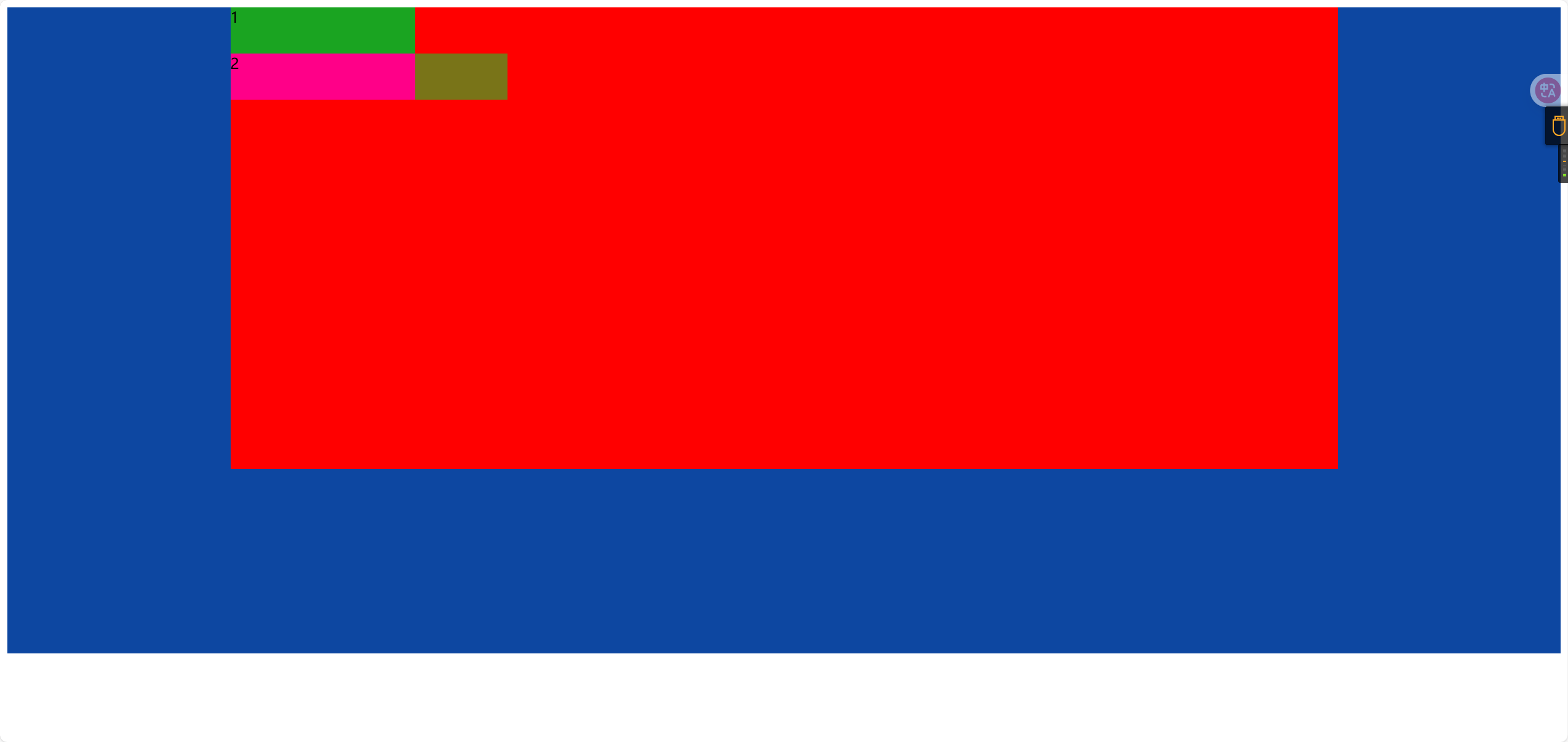
<!DOCTYPE html>
<html lang="en">
<head>
<meta charset="UTF-8">
<title>相对定位</title>
<style>
.container {
background-color: #0d47a1;
width: 100%;
height: 700px;
}
.demo {
margin: 0 auto;
background-color: red;
width: 1200px;
height: 500px;
position: relative;
}
.item1 {
width: 200px;
height: 50px;
background-color: #1aa421;
}
.item2 {
width: 200px;
height: 50px;
background-color: #ff0088;
position: absolute;
}
.item3 {
width: 300px;
height: 50px;
background-color: #797418;
}
</style>
</head>
<body>
<div class="container">
<div class="demo">
<div class="item1">1</div>
<div class="item2">2</div>
<div class="item3">3</div>
</div>
</div>
</body>
</html>
2
3
4
5
6
7
8
9
10
11
12
13
14
15
16
17
18
19
20
21
22
23
24
25
26
27
28
29
30
31
32
33
34
35
36
37
38
39
40
41
42
43
44
45
46
47
48
49
50
51
52
53
# 子绝父相
这个“子绝父相”太重要了,是我们学习定位的口诀,时时刻刻记住的。
这句话的意思是 子级是绝对定位的话, 父级要用相对定位。
首先, 我们说下, 绝对定位是将元素依据最近的已经定位绝对、固定或相对定位)的父元素(祖先)进行定位。
就是说, 子级是绝对定位,父亲只要是定位即可(不管父亲是绝对定位还是相对定位,甚至是固定定位都可以),就是说, 子绝父绝,子绝父相都是正确的。
所以,我们可以得出如下结论:
因为子级是绝对定位,不会占有位置, 可以放到父盒子里面的任何一个地方。
父盒子布局时,需要占有位置,因此父亲只能是相对定位。
这就是子绝父相的由来。
# 固定定位fixed(认死理型)
固定定位是绝对定位的一种特殊形式,它以浏览器窗口作为参照物来定义网页元素。当position属性的取值为fixed时,即可将元素的定位模式设置为固定定位。
当对元素设置固定定位后,它将脱离标准文档流的控制,始终依据浏览器窗口来定义自己的显示位置。不管浏览器滚动条如何滚动也不管浏览器窗口的大小如何变化,该元素都会始终显示在浏览器窗口的固定位置。
固定定位有两点:
- 固定定位的元素跟父亲没有任何关系,只认浏览器。
- 固定定位完全脱标,不占有位置,不随着滚动条滚动。
记忆法: 就类似于孙猴子, 无父无母,好不容易找到一个可靠的师傅(浏览器),就听的师傅的,别的都不听。
← box-sizing样式解析 网格布局 →
